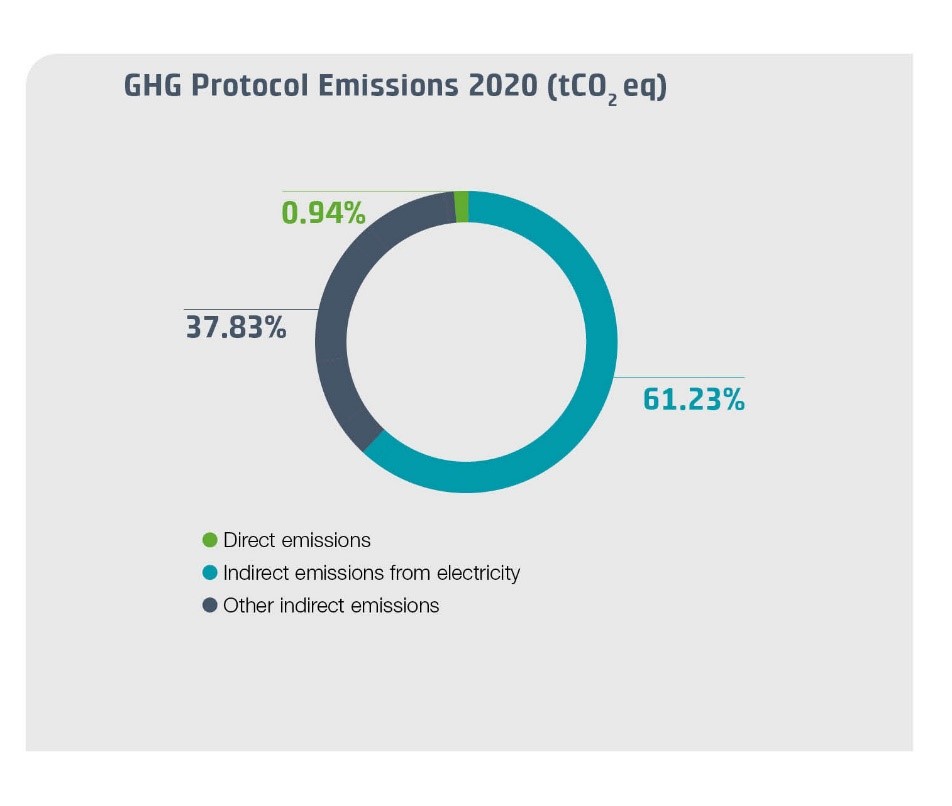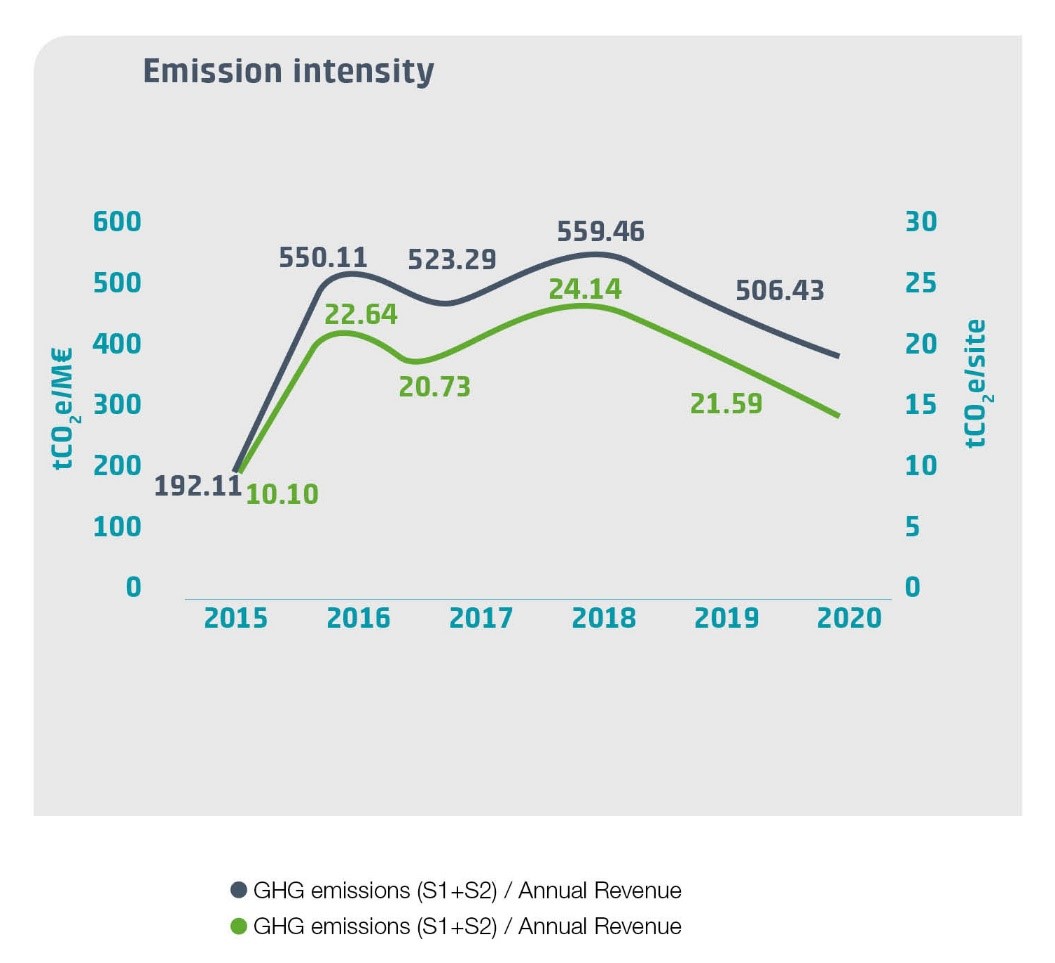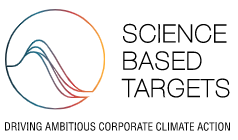Carbon footprint and climate change
Once again, this year, Cellnex measured and obtained independent third-party confirmation of its carbon footprint, to ascertain the company's impact on climate change and to set a baseline for managing and reducing its emissions. Since the foundation of Cellnex in 2015, the carbon footprint has been calculated yearly at group level. Each year, the companies acquired by Cellnex are incorporated into the carbon footprint calculation. The operational scope is based on the ISO 14064-1:2018 as well as the GHG Protocol criteria.
Cellnex Netherlands
Cellnex has carried out in 2020 a complete Screening of its indirect emissions for the eight countries where Cellnex is already operating, in order to determine their significance as per the GHG Protocol Corporate Value Chain (Scope 3) and the ISO 14064-1:2018. This will be the basis on which the emission reduction targets will be defined to keep the increase in global temperature below 1.5 °C, as marked by the Science Based Target initiative (SBTi) to which Cellnex has joined. These relevant categories have also been included in the carbon footprint calculation, that has been verified following the ISO 14064-1:2018 Standard. In addition, and due to the expansion of the countries where the company operates and the addition of indirect GHG emission categories as set out in the new International Standard ISO 14064-1: 2018, Cellnex Telecom has decided to modify its base year. In short, the organization has established 2020 as the base year for GHG emissions for comparative purposes and other GHG programs requirements and intended uses.
The inventory of GHG emissions becomes, therefore, a key instrument to know the global dimension of the impact of the company's activity on climate change, as well as the evolution of its GHG emissions over time. The results obtained in the GHG emissions inventory will be useful to respond to the sustainability index in which the organization participates, such as FTSE4GOOD, CDP, Sustainalytics and “Standard Ethics”. It is worth mentioning that for the second year in a row, Cellnex has been recognised for its commitment to sustainability and the fight against climate change by CDP –which manages a global disclosure system for investors, companies, cities, states and regions to measure their environmental impact–, securing a place on its prestigious ‘A List’.
Moreover, the new internal audit program started in 2020 in four countries will be consolidated and extended to the rest of the countries. Additionally, thanks to the collection of employee commuting data for the carbon footprint Scope 3 Screening, a basic global mobility study is being undertaken. In countries like France for instance, all vehicles used by the company are already hybrid.
According to the verification, the verified emissions inventory for 2020 is 303,819 t CO2e with the market-based approach (205,051 t CO2e in 2019). The increase in emissions is mainly due to the inclusion of new sources of indirect emissions as a result of the Scope 3 Screening (indirect emissions) for the SBT, as well as the incorporation of new countries in the calculation of the carbon footprint.
| GHG PROTOCOL EMISSIONS (market-based) | ISO 14064 GHG EMISSIONS (market-based) | ||||
| Category | GHG emissions (t CO2e) |
% |
Category | GHG emissions (t CO2e) |
% |
Scope 1: direct emissions |
2,848.14 |
0.94% |
C1. Direct GHG emissions and removals |
2,848.14 |
0.94% |
Scope 2: indirect emissions from electricity |
186,025.52 |
61.23% |
C2. Indirect GHG emissions from imported energy (market) |
186,025.52 |
61.23% |
Scope 3: other indirect emissions |
114,945.18 |
37.83% |
C3. Indirect GHG emissions from transportation |
2,774.76 |
0.91% |
C4. Indirect GHG emissions from products used by organization |
112,170.42 |
36.92% |
|||
C5. Indirect GHG emissions associated with the use of products from the organizations |
0 |
0.00% |
|||
Total |
303,818.84 |
100.00% |
Total |
303,818.84 |
100.00% |
Furthermore, emissions are also reported with the classification established by The Greenhouse Gas Protocol (GHG Protocol) Corporate Accounting and Reporting Standard, developed by the World Business Council for Sustainable Development. In the case of Scope 3 emissions, the classification established in the publication of the GHG Protocol "Corporate Value Chain (Scope 3) Accounting and Reporting Standard" is used.
As shown in the previous table, 61.23% of the GHG emissions inventory corresponds to category “Scope 2: indirect emissions from electricity” (GHG Protocol) or “C2: indirect emissions from imported energy” (ISO 14064), followed by category “Scope 3: other indirect emissions”, with 37.83% of the total emissions (GHG Protocol), that corresponds to categories C3 and C4 (ISO 14064).
The main reason of the high percentage of contribution of the Scope 2 category is that Cellnex do not have yet renewable electricity consumption in most of their countries. Regarding Scope 3 Category, it is composed mainly of GHG emissions derived from the purchase of good and services and capital goods during 2020, and the emissions related to the production of fuels and energy purchased and consumed by Cellnex in the reporting year that are not included in Scope 1 or Scope 2.

The evolution of the company's growth in recent years, as well as the expansion of indirect emission sources, has led to a change in the base year of calculation, being 2020 the new base year established. Thus, with the aim of offering comparable data to evaluate the evolution of emissions in recent years, only the trend of scopes 1 and 2 are shown over the years in relation to revenues and the number of sites, as indicators of emissions intensity.
As part of its efforts to manage greenhouse gas emissions, in 2020 Cellnex Telecom offsetted 2,850 t CO2 by purchasing 2,850 VER (Verified Emissions Reductions) credits on the voluntary market from the Rio Taquesi Hydroelectric Power Project in Bolivia, with the Verified Carbon Standard (VCS), to achieve neutrality in Scope 1 carbon footprint emissions from all countries.
Regarding noise and light pollution, Cellnex's activity does not produce a significant impact. Even so, Cellnex takes these impacts into account and works to minimize them. Cellnex Netherlands received two complaints related to light disturbance during night and two associated to noise disturbance. Complying with the process, grievances were carried out to be resolved as an incident.
Science-Based Targets Initiative


Cellnex Telecom is firmly committed to reducing its carbon emissions. In October 2019 (signed in July), Cellnex undertook to develop a Science-Based Emission Reduction Target over the following 24 months, which will be recognised by the Science-Based Targets Initiative. In this regard, Cellnex has been working to match all the necessary criteria to submit to the SBT initiative before 30 June 2021.
The Science-Based Targets Initiative, aligned with the Paris agreement (COP 21, 2015), is a joint initiative by CDP, the UN Global Compact, the World Resources Institute and WWF, which supports companies in setting emission reduction targets in line with the level of decarbonisation required to keep the global temperature increase below 2ºC compared to pre-industrial levels. The targets are calculated using methodologies based on scientific knowledge and making it the dominant practice.
Likewise, in 2019 Cellnex joined the Global Compact initiative “Business ambition for 1.5ºC”. This is a global initiative, signed by more than a hundred companies, 10% of which are Spanish. The initiative sets out two areas of action: "1.5°C science-based targets", aligning its GHG emissions in all relevant areas with emission scenarios at 1.5°C, and "Zero Emissions Commitment" setting a public target to achieve zero emissions by 2050. In this way, the Group is stepping up and committing the business to set science-based targets aligned with limiting the global temperature rise to 1.5°C above pre-industrial levels. In December, the Spanish Global Compact Network, together with the UN Global Compact, the Chilean Network and the British Network, held an event in the context of COP25 in which, in addition to presenting the commitments in the manifesto, publicly recognised the Spanish entities adopting Business Ambition for 1.5°C.
The company worked during 2020 to match all the necessary criteria prior to setting the SBT initiative:
- Boundaries (scopes 1+2)
- Timeframe (5 to 15 years)
- Level of ambition (temperature reduction below 1.5 ºC)
- Scope 3 (if it represents more than 40% of emission)
- Reporting (annual disclosure of emissions inventory in CDP, website)
After the results of the screening of the scope 3 it has been determined that a scope 3 target is not to be included initially in the SBTi. A timeframe will be also established, and the SBT will be completed and submitted to the SBT Initiative during the first semester of 2021.
Internal carbon price
During 2021-2022 Cellnex will conduct a study for the implementation and calculation of the Internal Carbon Price, with the aim of completing it in 2022.
The incorporation of the internal carbon price will be a key instrument in strategic decision-making (both at investment and operational level) at Cellnex Telecom. Among other aspects, it will enable the organisation to increase its positioning and corporate reputation with investors and improve its assessment in the various sustainability ratings in which Cellnex is involved, such as the CDP, and to make progress on possible regulatory changes linked to climate change.
The internal price of carbon is a financial tool that helps reflect the social, environmental and economic costs of climate change in relation to the greenhouse gas emissions generated by the consumption of energy and materials necessary for the daily activity of an organisation:
- It can add value to investments that reduce social, environmental and economic costs, thus creating incentives for innovation in low-carbon companies.
- It makes it possible to get ahead of policies that may affect the operations or the value chain of the company.
- It helps to achieve ambitious emission reduction targets.
- It translates the business impact on climate change into financial terms, helping to translate carbon into relevant terms for the company and to strengthen internal engagement.
- It responds to investor and customer demands.
- It improves corporate positioning on climate change.

